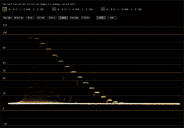
-
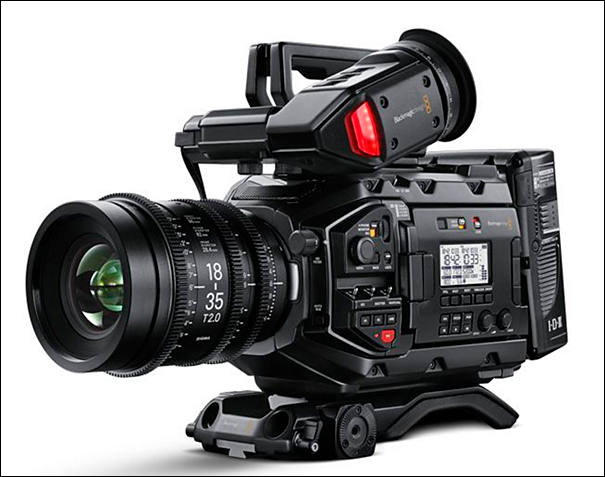
Key features:
- Digital film camera with 15 stops of dynamic range.
- Super 35mm 4.6K sensor with third generation Blackmagic Design color science processing of raw sensor data.
- Interchangeable lens mount with EF mount included as standard. Optional PL and B4 lens mount available separately.
- High quality 2, 4 and 6 stop neutral density (ND) filters with IR compensation designed to specifically match the colorimetry and color science of URSA Mini Pro.
- Fully redundant controls including ergonomically designed tactile controls which allow direct access to the most important camera settings such as external power switch, ND filter wheel, ISO, shutter, white balance, record button, audio gain controls, lens and transport control, high frame rate button and more.
- Built in dual C-Fast 2.0 recorders and dual SD/UHS-II card recorders allow unlimited duration recording in high quality.
- Lightweight and durable magnesium alloy body.
- LCD status display for quickly checking timecode, shutter and lens settings, battery, recording status, and audio levels.
- Support for CinemaDNG 4.6K RAW files and ProRes 4444 XQ, ProRes 4444, ProRes 422 HQ, ProRes 422, ProRes 422 LT, ProRes 422 Proxy recording at Ultra HD and HD resolutions.
- Supports up to 60 fps 4.6K resolution capture in RAW.
- Features all standard connections, including dual XLR mic/line audio inputs with phantom power, 12G-SDI output for monitoring with camera status graphic overlay and separate XLR 4 pin power output for viewfinder power, headphone jack, LANC remote control and standard 4 pin 12V DC power connection.
- Built in high quality stereo microphones for recording sound.
- 4 inch foldout touchscreen for on-set monitoring and menu settings.
- Includes full copy of DaVinci Resolve software color grading and editing software.
-
PR
Fremont, California, USA – March 2, 2017 – Blackmagic Design today announced URSA Mini Pro 4.6K, a new professional camera that combines high end digital film quality with the ergonomics and features of a traditional broadcast camera. URSA Mini Pro features a massive number of tactile control buttons, switches and dials that make it faster to use, built in optical ND filters, a new interchangeable lens mount, dual CFAST 2.0 and dual SD/UHS-II card recorders, and much more.
URSA Mini Pro 4.6K is available now for $5,995 from Blackmagic Design resellers worldwide.
The new URSA Mini Pro combines the best digital film technology with the most advanced broadcast features and ergonomics available, making it perfect for use in high end feature films, television shows, commercials, and indie films as well as broadcast news, studio and even live multi camera production.
URSA Mini Pro is designed to be the toughest and most fully featured camera available. It includes everything customers need in a compact handheld magnesium alloy body that’s durable and light enough to use anywhere. There’s an external high visibility LCD status display for viewing critical shooting information, a foldout touch screen for reviewing shots without needing an extra on-set monitor, professional connections such as 12G-SDI, XLR audio, built in high quality stereo microphones and more. Plus, every single control on the camera is redundant, including the power, so if anything should go wrong in the field, the camera can still be used.
When it comes to image quality, URSA Mini Pro features a custom 4.6K image sensor that captures up to 4608 x 2592 pixels with a massive 15 stops of dynamic range and a super wide color gamut. Third generation Blackmagic Design color science is used to process the raw sensor data, enabling amazingly rich skin tones, natural color response and an enormous amount of dynamic range. URSA Mini Pro is ideal for everything from standard rec. 709 broadcast HD to the latest rec. 2020 high dynamic range digital film production.
URSA Mini Pro features neutral density (ND) filters with IR compensation for quickly reducing the amount of light that enters the camera. The 2, 4 and 6 stop filters are specifically designed to match the colorimetry of the camera and provide additional latitude, even under harsh lighting conditions. That means customers can use different combinations of aperture and shutter angle to achieve shallower depth of field, or specific levels of motion blur, in a wider range of situations. The IR filters evenly compensate for both far red and infrared wave lengths to eliminate IR contamination. The ND filters are true optical filters with a precision mechanism that quickly moves them into place when the ND filter dial is turned.
The broadcast camera ergonomics of URSA Mini Pro put powerful tactile control buttons, switches, knobs and dials on the outside of the camera, giving customers direct access to the most important camera settings. The controls are laid out in a logical order that makes them easy to remember so cinematographers can operate the camera without having to look at the buttons, hunt through menus, or take their eye off of the action. URSA Mini Pro also features a high visibility status screen that displays important information such as timecode, shutter and lens settings, battery, recording status, and audio levels. The status display features a backlight and is designed to be clearly visible in both dimly lit studios and outside in direct sunlight.
URSA Mini Pro has a revolutionary new interchangeable lens mount that makes it compatible with virtually all professional lenses so customers can choose exactly the right lens for the job. Included standard is an EF mount for working with high quality photographic lenses. If the camera is being used on a high end film or commercial shoot that calls for large cinematic lenses, simply remove the EF mount and replace it with the PL mount. There’s even a B4 broadcast lens mount for working with broadcast HD lenses. URSA Mini Pro also includes a standard 12 pin Hirose lens control connector. URSA Mini Pro comes with an EF mount and customers can purchase the optional PL and B4 lens mounts separately.
Featuring both dual C-Fast 2.0 recorders and dual SD/UHS-II card recorders, customers can choose the media that works best for their projects. C-Fast cards are ideal for full resolution RAW recording, while UHS-II SD cards are inexpensive and commonly available, making them perfect for recording ProRes Ultra HD files or RAW HD files. Simply choose the media type, insert the cards and start shooting. With dual slots for each media type, the camera never has to stop recording because when the first card is full, it automatically continues onto the next card. Full cards can be swapped for empty ones, all without stopping the camera. URSA Mini Pro can record lossless 12-bit CinemaDNG RAW files for the highest possible quality, or 10-bit ProRes files for easy post production workflows with minimum storage requirements.
URSA Mini Pro includes the full DaVinci Resolve Studio software, giving customers a complete post production solution. This powerful software combines professional nonlinear video editing with the world’s most advanced color corrector for importing, editing, color correcting, finishing and delivering projects shot on URSA Mini Pro. DaVinci Resolve Studio works natively with the RAW and ProRes files from the camera, so customers can take them directly into post production without having to convert or change them. Every single bit of quality is preserved because it is a true lossless workflow. Using DaVinci Resolve Studio is the fastest and highest quality way to work with files from URSA Mini Pro.
Availability and Price
URSA Mini Pro is available now from Blackmagic Design resellers worldwide for US$5,995. Also available from resellers are the optional URSA Mini Pro PL lens mount for US$245, as well as the optional URSA Mini Pro B4 HD lens mount for US$385. URSA Mini Pro comes standard with an EF lens mount, and additional replacement mounts can also be purchased for US$175.
Blackmagic URSA Mini Accessories
- Blackmagic URSA Mini Pro PL and B4 lens mounts each sold separately.
- Additional Blackmagic URSA Mini Pro EF lens mounts also sold separately.
- Blackmagic URSA Mini Shoulder Kit features built in rosettes, rail mounts, viewfinder mount, integrated tripod quick lock release and top handle.
- Blackmagic URSA Viewfinder is a high resolution viewfinder that includes a full HD OLED display and true glass optics for perfect focus.
- Blackmagic URSA Studio Viewfinder featuring 7” screen, variable tension mounting points, grab handles, external controls and more.
- URSA VLock Battery Plate provides a VLock compatible plate for attaching third party batteries.
-
I had my credit card out, then slowly tucked back into my wallet...
sounds like a decent prototype for a future 6K and 8K coming BM camera in the next 2 years, or what the ursa mini should have been 2 years ago, but no sensor or image improvements?
yikes, I've been rather bored of all camera releases since the h.265 Samsung NX1 almost 2.5 years ago!!
In the meanwhile, we can wait for drones and cell phones to go 8K VR, just now checking out toys like the $3000 Insta360 Pro standalone ball-shaped aluminum unit with six built-in fisheye cameras, photos AND videos at 7680 x 3840/30 fps, or 8K, as well as real-time streaming at 4K/30 fps, using it's multiple camera options to provide 3D stereo vision, either at 4K/25 fps as a live stream, or at 6K/30 fps to post-processed
-
@NickBen what are you talking about?!? 15 stops 4,6k raw is outdated specs? You think that somebody needs 8k camera for real work, or may be 16k or 32k would be better? Even 4k is too much for lots of real projects today. All that things about 6k or 8k is for smartphone marketing and for geeks who love talking about numbers, but never shooting for real!
-
im with nick, this is BS , you could have added the nd filter and sd card from the start and sold it with the mini 4.6k , its really nothing more than that , the image is the same , nothing has changed other than few physical specs to camera and operations.... it seems they want to milk this 4.6k sensor for a while, now im almost sure that they will have a small pocket like camera at NAB this year with this sensor ...for me the sensor is good, but its still lacks something .... side note what happen to all the big ursa owners who were told buy this and we will upgrade the sensor with time...if i was one of these people i would be very upset now.
-
I'm totally pleased by the new mini Pro. I have a URSA mini and I love it, I wouldn't exchange it for a RED, I love the color science, size, features. Adding an ND filter, SD slots, interchangeable mount and some other little things makes it the most versatile RAW cinema camera. And still, incredibly, the cheapest. I really cannot understand the people who criticizes it.. probably they have no idea of time and costs to develop a new sensor (and a camera around it), have no idea of why RED and ARRI didn't put ND filters in their cameras, and so on. This is a great upgrade to current mini, at a ridicuolous price tag (+1000)
-
good luck selling your mini 4..6k now for only a 1000$ cheaper than the pro, more likely this upgrade will be 2000$ in the end, which they would have just had that from the start
-
Lol, I read prototype for a future 6K/8K camera...? where is the stop of the K's war? a 64K camera? The human eye has physical limitations, 1080 are more than enough, 2.5K and 4K so enough . The rest is marketing.
Sorry for the off topic.
-
For delivery, that may be true. For capture, more pixels let you do things like stabilize and reframe without loss of quality.
-
Tom Antos gives solid advice on this camera... simply wait till NAB 2017 for new announcements in video below 31:15 thru 36:40 unless you need to shoot/rent today
-
Just made a long test of the Ursa Mini 4.6K Pro recentIy, but I don’t have the time to translate all that.
May add some pictures and more stuff later.So, just a few observations.
Great news:
– true broadcast style operation with mechanical switches, buttons and knobs
– built-in ND filters with proper IR-filtering
– user-changeable lens mounts
– shimming not only for PL- but EF-mount too
(very helpful to make zooms parfocal, but EF still sucks with large tolerances, while PL is adjust once and for all)
– LCD-Display in B&W with good daylight visibility
– lens contacts for writing info into the metadata
– recording to cheap and ubiquitous SD-cards, split-recording up to RAW 3:1 in 25 fps, nice in PAL regions ;-)
– menu-wheel for immediate control without taking the eye off the viewfinder
– improved pre-amps when used with external microphones
– taking stills
– planned SSD recorder
– planned Bluetooth control
– planned Nikon mount with manual aperture control
Still good:
– the excellent viewfinder
– very intuitive menu-system
– good running times from the battery
– low noise of fan
Criticisms from the web, checked carefully:
– the „rainbow flare“ from the ND-wheel is there, but BM already announced a fix.
(It’s unclear, though, how this may interact with the Mosaic OLPF)
– magenta sides issue when certain lenses are stopped down: it’s there if you really want to find it.
(Easy fix in Resolve plus alleviated by the ND filters.)
– fixed Pattern Noise: it’s there, but only if you try to raise the shadows to crazy levels.
On the positive side, black shading is really fast compared to Red Scarlet, but that one is perfect regarding FPN.
– aliasing: yes, it's there, but far less critical than with lower resolution models.
(Many mid-range lenses don't resolve good enough to trigger the problem.)
Minor annoyances:
– the flip-out screen is a tad yellow and blocks interface elements in very low or high positions
– the ND-wheel lettering should make the difference between „clear“ and ND more obvious
(instead of numbers 1-4, but, OK, it’s written on the side)
– sometimes the EVF is dimming when not used in perfect position
– no zooming in beyond 2x on the screens
Bigger annoyances:
– the audio has massive delay on the headphones, closed headphones are a must
(getting better with higher fps)
– audio from the internal microphones has considerable hiss
(but better than earlier models)
– the grip is too short for tall people and getting it out of the way is fumble
Possible limitations in broadcast use:
– startup time is good, but still slower than typical broadcast-camcorders
– no fast AF
– no complex measuring and auto-exposure functions
– no 4K with B4-zooms
– no audio limiter
– the screen can’t be turned to the front for single person operation (aka selfies)
– low-light capacity not beyond 1600 ISO
– no TC preset
Missing:
– parallel recording for backup
– no proxy recording parallel to high-res or RAW
– no TC out
– no longer exposure times than 1/12 sec for time-lapse
Verdict:
The Ursa Mini 4.6K Pro is the most versatile camera with such image quality you can find at this price level (and beyond), but it’s not up to all tasks in demanding run-n-gun scenarios. Great for nature and documentaries with some crew and lights, though, plus all the things the Ursa Mini 4.6K could do.
BTW, we compared it side-by-side to the Red Scarlet MX, which sometimes can be found second-hand for a similar price level or at least below 10K (in a minimal shooting config).
You can see the MX is getting a bit outdated:
– needs more power
– makes more noise
– is a bit weaker in low-light
– longer start-up time
– no serious slo-mo
– calibration is very slow
But:
– good colors
– no FPN at all
– no aliasingComments and questions welcome!
-
Nomad .. not sure what other cameras you have tested etc but I have owned the original 4.6k ursa for year and half .. I keep going to same point ,something is off with image and motion.. I compared it to having a "fake rich look" not sure if it makes sense ,it's almost like dressing an ok looking girl in hot sexy clothes and nice makeup .. it needs lots of tweaking in post to get image to be very good ,over all the sensor to me is not that all that much better compared to original cinema camera, it's an improvement just not leaps ahead or major one in my eyes .. I do feel in a couple years black magic will finally get it right .. and I see great cameras ahead .
-
I tested both Ursa 4.6K models. Not much of a difference, but "screendoor" effect seems cured. But I've tested and worked with all Red cameras other than Helium, many Sonys and the Alexa. Color is quite subjective without charts and such, I'll post some soon. Motion is not different from any other camera with electronic shutter in my eyes. Only Red has a solution with their Motion Mount, but that costs light.
-
Here you go:
This test was done under natural daylight, just a few minutes apart, while the weather was overcast without any quick changes by clouds. Both cameras were using the same Zeiss Contax lens (distance adjusted for similar size) and were color-balanced with the graycard on the back of the color chart you are seeing. The Scarlet was recording compressed Redcode 6:1 and the Ursa Mini Pro was recording uncompressed DNG sequences. The footage was imported into DaVinci Resolve and both clips were set to Rec 709 for color space and gamma. No other corrections were made.
Left: Scarlet MX After all those years of refinement of their „color science“ (as Red calls it) the Scarlet MX really has good colors, whatever it’s reputation is. The nice thing about raw-recording: even footage from years ago will have better colors now. The only weakness are yellow, which is a tad too green and cyan is a bit too blue. But even magenta and green, which are critical with many cameras, nearly meet their targets – impressive! Skintones are very close to the I-beam and shouldn’t pose a problem.
Right: Ursa Mini Pro The UM Pro has skintones which are a tad too red, but it’ll be no problem to correct them. Actually, we had no problem to match the UM Mini (before we had the Pro around) to the Arri Alexa. Yellow is too warm, which is very obvious with the Scarlet next to it with it’s greenish yellow. Blue is shifted to cyan and green to yellow. Both magenta and green also are a bit weak. But, as I mentioned before, many cameras are weak in that axis, not only Sonys, but even Alexas. IMHO, there is nothing a good colorist couldn’t handle when grading. Or Epicolor, a nice plug-in I'll soon write about.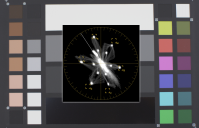
 Farbkarte_Scarlet_Vec_sm.png1556 x 1000 - 2M
Farbkarte_Scarlet_Vec_sm.png1556 x 1000 - 2M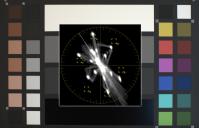
 Farbkarte_UMP_Vec_sm.png1555 x 1000 - 2M
Farbkarte_UMP_Vec_sm.png1555 x 1000 - 2M -
Well, DR is highly subjective if you don't have perfect testing equipment. I didn't have a Xyla 21 (from DSC) this time, which is the best thing I know for testing DR, but really expensive. It needs a pitch black room with black walls, BTW, a true studio.
With that I could see 14.5 stops from the Alexa, but the lowest half stop was hardly useable. Under identical conditions we tested the Epic MX and it showed 11.5 stops, again with the lowest one nearly drowned in noise. Since I could compare the UMP this time to an MX sensor and it was about 1 to 1.5 stops better, your observation seems about right.
But not only what is useable at the lowest value is subjective. Different cameras start to show weaker colors close to clipping and even in this respect the Alexa is a bit better than the UM (I tested the older UM 4.6K against one).
So, the Alexa is still on top, but let's not forget it has larger photocells. Bigger buckets collect more rain ;-)
Finally, here is a comparison of the noise, both recorded after coming to working temperature and then black shaded. Pulled up massively until they reach about the same level around 50 IRE. You can't really compare them at the original level, since the Scarlet MX doesn't really touch black at all, while the UMP seems to be clamped to black when you have a cap on the lens.
Scarlet on the left again, and two crops of the noise pattern pulled up, but not enhanced in any way. For you pixel peepers: just pull up the contrast, zoom in etc. to your hearts delight, until you see the noise patterns ;-)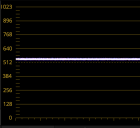
 Scarlet_Noise.png630 x 576 - 32K
Scarlet_Noise.png630 x 576 - 32K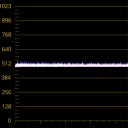
 UM46Pro_Noise.png559 x 559 - 40K
UM46Pro_Noise.png559 x 559 - 40K
 Scarlet_Noise_only.png354 x 350 - 79K
Scarlet_Noise_only.png354 x 350 - 79K
 UM46Pro_Noise_only.png421 x 421 - 135K
UM46Pro_Noise_only.png421 x 421 - 135K -
Wow thanks for detailed info ! Just like I thought ,and you pointed out the color loss info with useable stops with ursa camera compared to alexa and how in reality it may be only 1.5 stop difference(which still big) ,but to the eye it looks even more (because alexa retain better color info at both ends of the stop range) .. I also feel with regards ursa ,it feels like it's a mid tone camera ,what I mean by that mids look great with regards to colors but shadows and highlights (break fast with regards to clipping in top and colors at botom) .. not to mention ,the room to expose to the right with alexa is much more flexible (I think I even heard it's completely normal to over expose by 2 and can be by almost 4 stops and brought back) while not sure ursa I'll be able to go more than 1 or 1.5 stops over (to keep shadow detail) with out turning into bad clipping (to me the top end stops gradation not very smooth on ursa 4.6k sensor compared to mids)
-
**Blackmagic Design URSA Mini Pro and URSA 4K PL Cinema Camera Kit for $6490*
-
Are we to expect a new camera from Blackmagic Design this NAB with new sensor to replace the 4.6k sensor?
Howdy, Stranger!
It looks like you're new here. If you want to get involved, click one of these buttons!
Categories
- Topics List23,990
- Blog5,725
- General and News1,353
- Hacks and Patches1,153
- ↳ Top Settings33
- ↳ Beginners256
- ↳ Archives402
- ↳ Hacks News and Development56
- Cameras2,367
- ↳ Panasonic995
- ↳ Canon118
- ↳ Sony156
- ↳ Nikon96
- ↳ Pentax and Samsung70
- ↳ Olympus and Fujifilm101
- ↳ Compacts and Camcorders300
- ↳ Smartphones for video97
- ↳ Pro Video Cameras191
- ↳ BlackMagic and other raw cameras116
- Skill1,960
- ↳ Business and distribution66
- ↳ Preparation, scripts and legal38
- ↳ Art149
- ↳ Import, Convert, Exporting291
- ↳ Editors191
- ↳ Effects and stunts115
- ↳ Color grading197
- ↳ Sound and Music280
- ↳ Lighting96
- ↳ Software and storage tips266
- Gear5,420
- ↳ Filters, Adapters, Matte boxes344
- ↳ Lenses1,582
- ↳ Follow focus and gears93
- ↳ Sound499
- ↳ Lighting gear314
- ↳ Camera movement230
- ↳ Gimbals and copters302
- ↳ Rigs and related stuff273
- ↳ Power solutions83
- ↳ Monitors and viewfinders340
- ↳ Tripods and fluid heads139
- ↳ Storage286
- ↳ Computers and studio gear560
- ↳ VR and 3D248
- Showcase1,859
- Marketplace2,834
- Offtopic1,319
Tags in Topic
- camera 247





